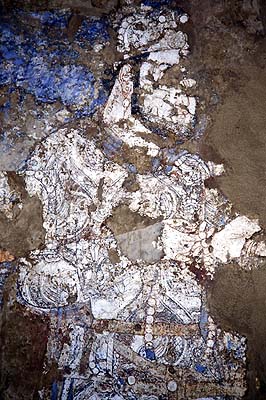
| Court art of Sogdian Samarqand in the 7th century AD | |||||||||||||
| Home | General | Western Wall | Northern Wall | Eastern Wall | Southern Wall | Bibliography | |||||||
 |
|
|||||||||||||||||||||||||||||||||||||||||||
Western wall
 |
At a first sight everything with figure 4 seems to be clear: The man has on his neck a Sogdian
inscription reading "Varxuman" - the name of the king mentioned in the great inscription.
|
We had clarified on other pages that figure 4 is not the leading man in his group of delegates. He is only the second. This is somewhat confusing because we should await the king as leading person in his delegation. Now, as with other inscriptions on persons also this one seems to be secondary, later than the paintings and the great inscription (as was stated by V. A. Livšic).
Obviously, at a time when the palace room had lost his original function and the paintings began to decay (especially the upper parts), literate visitors inscribed some of the figures. They knew that figure 4 was a princely one and so they thought him to represent Varxuman. The person in front of figure 4 was at this time still visible1 and possibly to identify (by appearance and by an inscription?) as a king, but not Varxuman. Therefore the visitors took into account a certain smilarity of both figures 4 and 4A and named no. 4 with "Varxuman".
What follows? Firstly this: Originally, figure 4 could by no means have meant Varxuman. Figure 4 stands subordinate and is not depicted in sufficient size: As can be seen on other walls the main actors were painted more than double the size of their companions [cp. northern wall and southern wall].
Secondly, figure 4A in front of figure 4 also was no main actor of the scene. Although he must have represented a king too, the surrounding space on the wall is not sufficient enough to reconstruct a doublesized person.
In conclusion: the delegates we are faced with figures 2, 3, 4, and 4A are not Samarqandians. But what about their real identity?
Read the next page for a possible solution.
Back to main text (western wall)
| 1 - This can be taken as an archaeological fact. The two main destruction zones of the left part of the western wall result from deep pits of Karakhanid times |
 |
|
|||||||||||||||||||||||||||||||||||||||||||